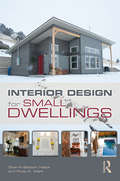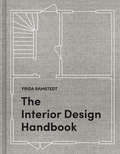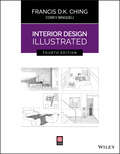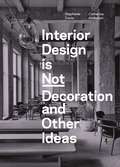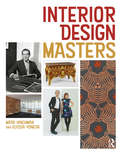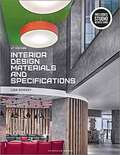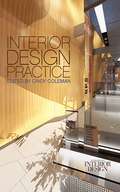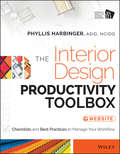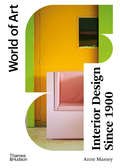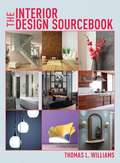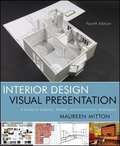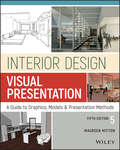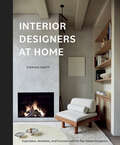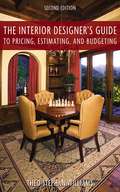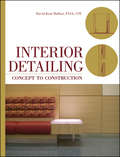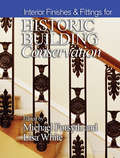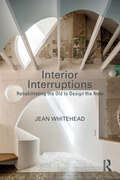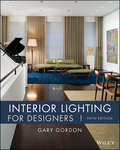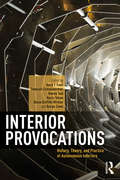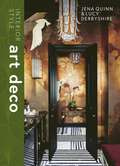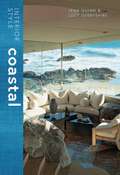- Table View
- List View
Interior Design for Small Dwellings
by Sherrill Baldwin Halbe Rose K MarkInterior Design for Small Dwellings addresses the onrush of interest in smaller homes and the possibility that small dwellings might be the answer to housing needs and sustainability. The book explores key principles essential to residing and designing small interiors with emphasis on client involvement and implementation of participatory, inclusive design as advocated by the Council for Interior Design Accreditation. Does living in a small space mean living small? The authors believe that by simplifying one’s life intelligently and applying certain principles of design, planning and organization, one can actually live a meaningful life in a smaller space. These tenets are based on the authors’ professional experiences and living in small homes. To this end, the book provides discussion, images, case studies, interviews, worksheets, activities and suggested explorations. Interior Design for Small Dwellings is a teaching guide and provides information and exercises that help professional designers utilize design theory, space planning and programming techniques. Throughout, the text affords sustainability, biophilic design and wellness methodologies.
The Interior Design Handbook: Furnish, Decorate, and Style Your Space
by Frida RamstedtPerfectly necessary for our current times: The new bible of interior design. While we spend more time at home than ever before, learn from the guru who has coached an entire Scandinavian generation in the art of creating a harmonious home.Frida Ramstedt believes in thinking about how we decorate, rather than focusing on what we decorate with. We know more today than ever before about design trends, furniture, and knickknacks, and now Frida familiarizes readers with the basic principles behind interior and styling--what looks good and, most of all, why it looks good.The Interior Design Handbook teaches you general rules of thumb--like what the golden ratio and the golden spiral are, the proper size for a coffee table in relation to your sofa, the optimal height to hang lighting fixtures, and the best ways to use a mood board--complete with helpful illustrations. Use The Interior Design Handbook to achieve a balanced, beautiful home no matter where you live or what your style is.
The Interior Design Handbook: Furnish, Decorate, and Style Your Space
by Frida RamstedtThe new comprehensive bible of interior design, from a home styling guru who has coached an entire Scandinavian generation in the art of creating a harmonious home. Frida Ramstedt believes in thinking about how we decorate, rather than focusing on what we decorate with. We know more today than ever before about design trends, furniture, and knickknacks, and now Frida familiarizes readers with the basic principles behind interior and styling—what looks good and, most of all, why it looks good.The Interior Design Handbook teaches you general rules of thumb—like what the golden ratio and the golden spiral are, the proper size for a coffee table in relation to your sofa, the optimal height to hang lighting fixtures, and the best ways to use a mood board—complete with helpful illustrations. Use The Interior Design Handbook to achieve a balanced, beautiful home no matter where you live or what your style is.
Interior Design Illustrated
by Francis D. Ching Corky BinggeliThe bestselling guide to interior design, updated with new code and technology Interior Design Illustrated is the definitive guide to design for interior spaces. Richly illustrated in author Francis Ching’s signature style, this book introduces complex design concepts in a visually stunning format; from defining the space and using the elements of design, to planning building systems and incorporating sustainable materials, this volume embodies the idea that beauty and function are not separate entities, but two parts of a whole. This new fourth edition has been updated to reflect the latest building codes and design practices, with discussion of new materials related to acoustics, lighting, and sustainable furnishings. Renewed attention to sustainability includes new information on energy conservation, design for longevity and adaptive reuse of existing buildings, as well as an updated discussion on LED lighting, workplace design, use of color, and computer modeling software to provide a well-rounded view of how interior design firms are working today. This classic text brings the elements and principles of design to life, giving students the practical skills they need to transition from idea to concept. Understand the latest building codes and how to integrate them into your design Explore new advances in materials, lighting, and wireless technology Design from a perspective of sustainability, longevity, and energy efficiency Delve into BIM, including software for modeling lighting, acoustics, and more Interior designers work at the intersection of aesthetics, functionality, regulations, accessibility, sustainability, and technology. There’s no one formula for getting it right, only an eye trained by experience, based on a mastery of design fundamentals. Interior Design Illustrated begins laying that foundation, guided by a leading global authority in the field.
Interior Design is Not Decoration And Other Ideas: Explore the world of interior design all around you in 100 illustrated entries
by Catherine Anderson Stephanie TravisAn inspiring book exploring all aspects of interior design in 100 engaging and beautifully illustrated entries.Interior design is not about paint colors and accent cushions. It is an important practice that affects all our lives. This entertaining book explores the world of interior design with a snappy set of 100 entries, all explaining what interior design is in an attractive format. The wide range of topics covered just proves that interiors are an integral part of our lived experience. The book will appeal to students, professionals, and anyone interested in the fascinating subject of what surrounds us.Contents: media and culture psychology concepts space project types materials environment and wellbeing technical issues the profession
Interior Design is Not Decoration And Other Ideas: Explore the world of interior design all around you in 100 illustrated entries
by Catherine Anderson Stephanie TravisAn inspiring book exploring all aspects of interior design in 100 engaging and beautifully illustrated entries.Interior design is not about paint colors and accent cushions. It is an important practice that affects all our lives. This entertaining book explores the world of interior design with a snappy set of 100 entries, all explaining what interior design is in an attractive format. The wide range of topics covered just proves that interiors are an integral part of our lived experience. The book will appeal to students, professionals, and anyone interested in the fascinating subject of what surrounds us.Contents: media and culture psychology concepts space project types materials environment and wellbeing technical issues the profession
Interior Design Masters
by Mark Hinchman Elyssa YonedaInterior Design Masters contains 300 biographical entries of people who have significantly impacted design. They are the people, historical and contemporary, that students and practitioners should know. Coverage starts in the late Renaissance, with a focus on the twentieth and twenty-first centuries. The book has five sections, with the entries alphabetical in each, so it can serve as a history textbook and a reference guide. The seventeeth- and eighteenth-century section covers figures from Thomas Chippendale to Horace Walpole. The nineteenth-century section includes William Morris and Candace Wheeler. The early twentieth-century section presents modernism’s design heroes, including Marcel Breuer, Eileen Gray, and Gilbert Rohde. The post-World War II designers range from Madeleine Castaing to Raymond Loewy. The final contemporary section includes Ron Arad and the Bouroullec brothers. These are the canonical figures who belong to any design history. The book also contains less well-known figures who deserve attention, such as Betty Joel, the British art deco furniture designer; Paul Veysseyre, the Frenchman active in China in the 1930s; and more recently Lanzavecchia-Wai, the Italian-Singaporean duo whose work ranges from health care to helicopters. Global in its coverage, the book is richly illustrated with over 600 black-and-white and color photographs.
Interior Design Materials and Specifications
by Lisa GodseyThis complete guide to the selection of materials for interiors has been updated to reflect the most recent materials on the market and contemporary awareness on industry movements like sustainability. Written from the viewpoint of the working designer, Interior Design Materials and Specifications, 4th Edition, describes each material’s characteristics and teaches students how to evaluate, select, and specify materials, taking into account factors including code compliance, building standards, sustainability guidelines, human needs, and bidding processes. Students will learn how to communicate with suppliers and vendors to achieve the results they envision and how to avoid some of the pitfalls common to material selection and specification. <p><p> New to this Edition:<p> -Removed laminated materials chapter and dispersing information into related materials chapters<p> -Inclusion of a Smart Materials chapter and sustainability information throughout<p> -Updated all case studies throughout text<p>
Interior Design on Edge: History, Theory, Praxis
by Erica Morawski Deborah Schneiderman Keena Suh Karin Tehve Karyn ZieveInterior Design on Edge explores ways that interiors both constitute and upset our edges, whether physical, conceptual or psychological, imagined, implied, necessary or discriminatory.The essays in this volume explore these questions in history, theory, and praxis through a focus on different periods, cultures, and places. Interior Design on Edge showcases new scholarship that expands and contests traditional relationships between architecture, interiors, and the people that use and design them, provoking readers to consider the interior differently, moving beyond its traditional, architectural definition. Focusing on the concept of interiority considered in a wider sense, it draws on interdisciplinary modes of investigation and analysis and reflects the latest theoretical developments in the fields of interior design history and practice.With new research from both established and emerging authors, this volume will make a valuable contribution to the fields of Interior Design, Architecture, Art and Design History, Cultural History, Visual Culture Studies, and Urban Studies.
Interior Design Practice (Interior Design Ser.)
by Cindy ColemanInterior Design magazine has assembled some of the most notable voices in the interior design world today under editor-in-chief Cindy Coleman to define contemporary interior design and its practice. Interior Design Practice provides aspiring and practicing professionals a perspective that is as broad as it is deep, encompassing design theory and education, global professional practice, and the experiences of design firms large and small. An overview is provided of the development and growth of the profession, along with an in-depth assessment of the legal and regulatory environment. An extensive section is offered on the work process, ranging from pre-design, programming, and design development to contract administration. Finally, a section on management provides a thorough exploration of issues in marketing, financial management, project management, and managing client relationships. Both comprehensive and timely,Interior Design Practice describes the changes currently occurring in the design profession and industry and suggests new, unique ways of thinking and working that will serve as a catalyst for designers who seek excellence in their profession. List of Contributors, their company, and their location: - Edward Friedrichs, (former President, Gensler) San Francisco - Derrel Parker, Parker Scaggiari,Las Vegas - Cindy Coleman, Chicago - Beth Harmon Vaughan, Gensler, Phoenix - Barry LePatner, LePatner & Associates, LLP, New York - Eva Maddox, Perkins + Will, Chicago - Sharon Turner, Swanke Hayden Connell Architects, London - Pamela Anderson Brule, Pamela Anderson Brule Architects, San Jose - Orlando Diaz-Azcuy, San Francisco - Stuart Cohen, Cohen/Hacker Architects, Chicago - David Boeman, Powell + Kleinshmidt, Chicago - Greg Switzer, Robert Sutter, Switzer Architects, New York - Lisabeth Quebe, (Former VP, Perkins + Will) Soldiers Grove, WI - Gary Wheeler, Wheeler Kanik, Richmond, UK - Kathy Rogers, Jacobs Facilities, Arlington, VA
The Interior Design Productivity Toolbox: Checklists and Best Practices to Manage Your Workflow
by Phyllis HarbingerGet organized and streamline your workflow with this A-Z accountability system. Design is only part of an interior designer’s job—you’re also responsible for scheduling client meetings, conducting design surveys, creating drawings and specs, and overseeing installation. Multiply by the number of projects on your plate, and you have a recipe for overwhelming disorganization. The Interior Design Productivity Toolbox helps you juggle multiple projects with ease, with a comprehensive self-management system tailored to the needs of interior designers and decorators. Features include: Detailed checklists that highlight weak spots and warn against common pitfalls Covers residential design, contract design, specifications, and renovations Best practices for meetings, design surveys, drawings, specifications, and renovations Customizable online checklists for tracking every phase of your project Exclusive online budgeting tool for tracking product costs and associated expenses to share with your team and your clients If you need to get organized and get back to work, you need The Interior Design Productivity Toolbox.
Interior Design Since 1900: Fourth Edition (World of Art #0)
by Anne MasseyNewly updated and overflowing with color, this well-established history of interior design describes and illustrates each movement and change in taste throughout the twentieth century. Interior design experienced an extraordinary amount of changes in taste and style during the twentieth century. From William Morris and the Arts and Crafts movement to expressionism, postmodernism, and green design, Interior Design Since 1900 charts them all. Featuring more than two hundred color illustrations of interiors from around the world, this book reveals the fundamental changes in style that occurred throughout the century. The 1900s saw the emergence of professional designers and a growing appetite to redesign homes to keep up with popular fashion. In recent decades, the focus has shifted toward public spaces and sustainable design. In this survey, Anne Massey explores the social, political, economic, and cultural contexts of these developments. This book has been a classic introduction to interior design for almost thirty years. The new, fourth edition is brought up-to-date with a chapter on transnational design, encompassing mid-century modernist work in Singapore and Sri Lanka, as well as more recent interior spaces, including luxury hotels in Dubai and a contemporary art museum in Cape Town. Through this book, Massey shows how a shared language of design and cutting-edge technology are reshaping interiors around the globe.
The Interior Design Sourcebook
by Thomas L. WilliamsConcrete that is light and translucent, fabric that responds to its environment by lighting up, tiles that can be moved from place to place at will-these are just a few of the updated entries you'll find in The Interior Design Directory. The book is divided into four parts, opening with a section on classic, composite materials including wood and stone, brick, and ceramic, then moving on to building materials that have been refined and updated for home use from glass, concrete, and metal to rubber and tiles. The final section is devoted to sustainable materials and the environmental impact of our choices. Photographs of contemporary interiors and detailed close-ups of each material make this as visually inspiring as it is practical.
Interior Design Visual Presentation
by Maureen MittonA practical, comprehensive guide to developing effective design communication skillsFrom doing a quick sketch to producing a fully rendered model, the ability to create visual representations of designs is a critical skill for every designer. Interior Design Visual Presentation, Fourth Edition offers thorough coverage of interior design communication used throughout the design process, complete with a broad range of real-world examples.This fully updated handbook presents the full range of styles and techniques used for interior design visual communication, from hand drawing to 3D computer modeling. Its accessible, how-to approach guides you through a variety of methods for executing creative and successful design graphics, models, and presentations. Recognizing the ongoing proliferation of digital tools for visual representation, this edition provides the latest information on 2D design presentation software, such as Photoshop, SketchUp, Revit, and AutoCAD. Dozens of high-quality, full-color illustrations highlight step-by-step instructions detailing techniques and approaches throughout the book.Standout features of this new edition include: Discrete chapters devoted to manual, freehand, and digital drawing Numerous examples of quick-sketching techniques as well as computer-generated, 3D representations using Google SketchUp and other software Updated coverage of graphics, composition, and organization of presentations A range of examples from small residential student projects to huge public interior spaces designed by leading professionals New coverage of rendering In-depth coverage of a wide range of material sample presentation boards From traditional to cutting-edge techniques, Interior Design Visual Presentation, Fourth Edition gives students and professionals alike the tools to give visual life to their design vision.
Interior Design Visual Presentation: A Guide to Graphics, Models and Presentation Methods
by Maureen MittonA newly updated and comprehensive guide to all aspects of visual design From doing a quick sketch to producing a fully rendered model, the ability to create visual representations of designs is a critical skill for every designer. Interior Design Visual Presentation, Fifth Edition offers thorough coverage of interior design communication used throughout the design process, complete with a broad range of real-world examples. This fully updated handbook presents a full range of styles and techniques used for interior design visual communication, from hand drawing to 3D computer modeling. Its accessible, how-to approach guides you through a variety of methods for executing creative and successful design graphics, models, and presentations. Recognizing the ongoing proliferation of digital tools for visual representation, this edition provides the latest information on software used in presentation such as Photoshop, and SketchUp, and covers the integration of Revit, and AutoCAD generated content into design presentations. • Covers all aspects of visual design and presentation for interior designers • Includes color illustrations that feature a wide range of project types including residential, healthcare and public projects, designed to highlight step-by-step instructions • Provides a discussion of incorporation of 3D digital models into presentations including use in virtual reality, and expanded information on scale models including a discussion of 3D printing • Includes a companion website for instructors, featuring PowerPoint lecture slides and an instructor's manual From traditional to cutting-edge techniques, Interior Design Visual Presentation, Fifth Edition gives students and professionals alike the tools to give life to their design vision.
Interior Designers at Home: Inspiration, Aesthetic, and Function with 20 Top Global Designers
by Stephen CraftiAuthor is well-connected with marketing channels and has a charismatic public presence. Books on interior designers' own homes are perennial sellers.
The Interior Designer's Guide to Pricing, Estimating, and Budgeting
by Theo Stephen WilliamsThis second edition is updated throughout and includes additional material on time management and numerous interviews with leading designers. Empowered by the step-by-step guidance in this book, interior designers will be able to establish prices and budgets that make their clients happy and their businesses profitable. Written by a designer and veteran expert on pricing, estimating, and budgeting systems, the book provides practical guidelines on how to value the cost of designing commercial or residential interiors, from the designer's creative input to the pricing of decorating products and procedures.The book shows how to determine a profitable and fair hourly rate, balance the client's budget with his or her wishes and needs, negotiate prices with suppliers and contractors, write realistic estimates and clear proposals, manage budgets for projects of all sizes and types, and position the firm's brand in relation to its practices. Interviews with experienced interior designers, case studies, and sidebars highlight professional pitfalls and how to master them, from daily crisis management and self-organization to finding the perfect office manager.
Interior Detailing
by Ballast David KentThe all-in-one interior detailing guide that unites creative and technical aspects A well-executed interior space requires the successful combination of the creative and the technical. Interior Detailing bridges the gap between design and construction, and shows how to develop and transform design concepts into details that meet the constraints, functional requirements, and constructability issues that are part of any interior design element. It offers guidance on how design professionals can combine imaginative thinking and the application of technical resources to create interiors that are aesthetically pleasing, functionally superior, and environmentally sound. Interior Detailing: Includes 150 easy-to-understand details showing how to logically think through the design and development of an assembly so that it conforms to the designer's intent and meets the practical requirements of good construction Describes how to solve any detailing design problem in a rational way Contains conceptual and practical approaches to designing and detailing construction components thatform interior spaces Shows how a small number of principles can be used to solve nearly any detailing problem This guide covers the subject of interior spaces comprehensively by balancing the contributions of physical beauty and structural integrity in one complete volume. By following the principles laid out in this book, interior designers and architects can plan for the construction of a unique interior environment more thoughtfully and with a clearer, better-defined purpose.
Interior Finishes and Fittings for Historic Building Conservation (Historic Building Conservation Ser.)
by Michael Forsyth Lisa WhiteInterior Finishes & Fittings for Historic Building Conservation complements Materials & Skills for Historic Building Conservation, combining the history and application of each material with current knowledge of maintenance and conservation techniques. Of direct practical application in the field, it takes the reader through the process of conserving historic interior finishes, covering everything from decorative plasterwork, joinery and paint colour; to chimneypieces, lighting and fire safety management. The series is particularly aimed at construction professionals – architects, decorative arts historians and specifiers, surveyors, engineers – as well as postgraduate building conservation students and undergraduate architects and surveyors as specialist or optional course reading. The series is also of value to other professional groups such as commissioning client bodies, managers and advisors, and interested individuals involved in house refurbishment or setting up a building preservation trust. While there is a focus on UK practice, most of the content is of relevance overseas (just as UK conservation courses attract many overseas students, for example from India, China, Australia and the USA). The chapters are written by leading conservators, historians, architects, and related professionals, who together reflect the interdisciplinary nature of conservation work. This volume on the historic interior is the fourth of a series on Historic Building Conservation that combine conservation philosophy in the built environment with knowledge of traditional materials and structural and constructional conservation techniques and technology: Understanding Historic Building Conservation Structures & Construction in Historic Building Conservation Materials & Skills for Historic Building Conservation Interior Finishes & Fittings for Historic Building Conservation While substantial publications exist on each of the subject areas - some by the authors of the Historic Building Conservation series - few individuals and practices have ready access to all of these or the time to read them in detail. The aim of the series is to introduce each aspect of conservation and to provide concise, basic and up-to-date knowledge within four volumes, sufficient for the professional to appreciate the subject better and to know where to seek further help.
Interior Interruptions: Rehabilitating the Old to Design the New
by Jean WhiteheadInterior Interruptions examines the role of the ‘palimpsest’ and its relationship to narrative, sustainability, renovation and adaptive reuse. By exploring storytelling, palimpsestic characteristics and techniques, the book argues that these devices play a central role in the consideration of the designed interior.Narrative has a burgeoning relationship with the palimpsest and this approach embraces an aesthetic of incompleteness and imperfection as a site rich response. It recognises the ongoing ‘biography’ or heritage of a building as a form of transient architectural narrative that encourages reuse through the continual process of writing, rewriting, overwriting and unwriting. This process has sustainable, societal, archaeological and textual connotations that can be interpreted as a process of ‘layering’ whereby the architectural shell is viewed as a container; a rich repository that is ‘overlain’ by surface changes, documents architectural and spatial modifications, and is populated by interior fixtures and fittings that all unite to create an ever-changing interior story.Exploring case studies from the UK, Netherlands, Palestine, Belgium, Singapore, Spain, Portugal, France, Germany, Brazil, Japan, USA and China and beautifully illustrated in full colour, this book proposes that the act of interior renovation can be viewed as a perpetual form of revisionary storytelling re-imagined as a series of temporal interior ‘interruptions’. It is essential reading for students and professionals interested in the built environment, including, but not limited to, interior design, interior decoration, interior architecture and architecture.
Interior Lighting for Designers
by Gary GordonThis revised edition of the successful primer thoroughly covers fundamentals of lighting design, and also serves as a handy reference for professional designers. The Fifth Edition is more comprehensive than ever, with new information on LED, energy efficiency, and other current issues. In addition, it includes more information for drawing ceiling floor plans and the application of designs to specific types of interiors projects. Considered a "key reference" for the Lighting Certified exam, no other text combines both technical and creative aspects of lighting design for beginners and novice designers.
Interior Provocations: History, Theory, and Practice of Autonomous Interiors
by Anca I. Lasc, Deborah Schneiderman, Keena Suh, Karin Tehve, Alexa Griffith Winton, and Karyn ZieveInterior Provocations: History, Theory, and Practice of Autonomous Interiors addresses the broad cultural, historical, and theoretical implications of interiors beyond their conventionally defined architectural boundaries. With provocative contributions from leading and emerging historians, theorists, and design practitioners, the book is rooted in new scholarship that expands traditional relationships between architecture and interiors and that reflects the latest theoretical developments in the fields of interior design history and practice. This collection contains diverse case studies from the late eighteenth century to the twenty-first century including Alexander Pope’s Memorial Garden, Design Indaba, and Robin Evans. It is an essential read for researchers, practitioners, and students of interior design at all levels.
Interior Style: Art Deco
by Jena Quinn Lucy DerbyshireArt Deco captures the vitality and modernity of the Jazz Age. From the refined interiors of 1920s Paris to the decadent and luxurious glamour of Hollywood, the bold geometry, simplicity of form and luxurious materials of Art Deco still feel distinctly modern today.With a historical overview and examples of stunning interiors, Interior Style: Art Deco explores the design essence of the era.With in-depth professional advice on how to use elements such as pattern, lighting, furniture and textiles, you will find the tools to recreate this sophisticated elegance in your own home.
Interior Style: Art Deco
by Jena Quinn Lucy DerbyshireArt Deco captures the vitality and modernity of the Jazz Age. From the refined interiors of 1920s Paris to the decadent and luxurious glamour of Hollywood, the bold geometry, simplicity of form and luxurious materials of Art Deco still feel distinctly modern today.With a historical overview and examples of stunning interiors, Interior Style: Art Deco explores the design essence of the era.With in-depth professional advice on how to use elements such as pattern, lighting, furniture and textiles, you will find the tools to recreate this sophisticated elegance in your own home.
Interior Style: Coastal
by Lucy Derbyshire Jenna QuinnExpansive, sun-drenched spaces, unobstructed views to the outdoors and easy-going comfort - coastal design captures the spirit and escapism of seaside living. Illustrated with breathtaking interiors and inspirational showpiece homes, Interior Style: Coastal traces the evolution of the aesthetic from the white villas of the Riviera to the California Look of the USA's West Coast. With in-depth professional advice on how to use elements such as colour, texture and pattern, you will discover how to bring the tranquillity of coastal life into your home.
